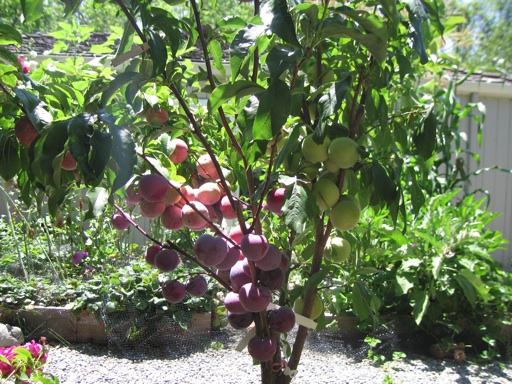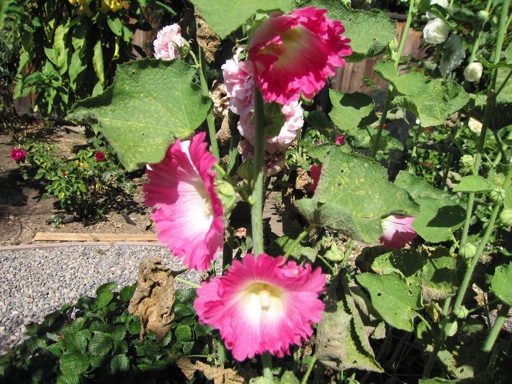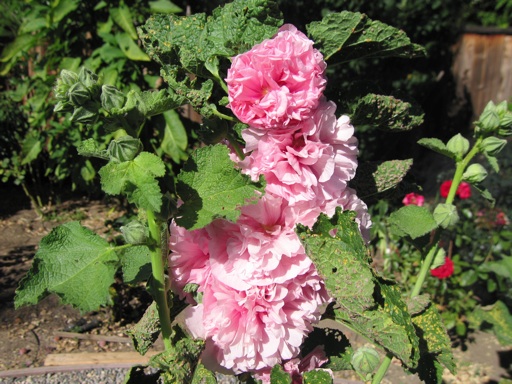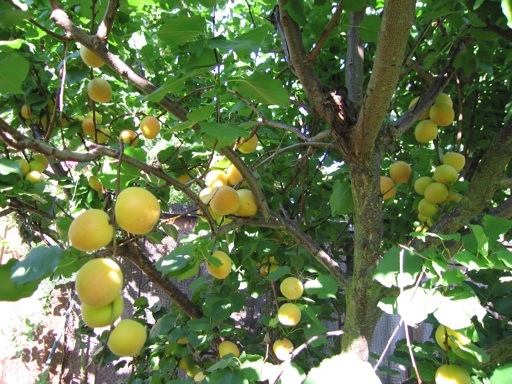Archive for July, 2012


I planted this pluot tree in our yard three years ago. It has four pluot scions grafted onto one tree. The four pluot scions are Flavor King, Flavor Queen, Flavor Supreme, and Dapple Dandy. This summer, it’s producing its first significant crop of fruit. Pluots are plum/apricot hybrids. I don’t care for many of the common home orchard plum varieties, such as Santa Rosa and Beauty, because they are too tart for me. But so far, I am really impressed with how good home grown pluots taste.
I have already harvested all of the Flavor Supreme Pluots. They were very tasty. The fruits are sweet with a bit of tartness. They ripen early and are mostly greenish in color. However, I have noticed so far that among the four scions on our tree, Flavor Supreme is the least vigorous grower. Also, Flavor Supreme doesn’t set as many fruits as the other three scions (only 4 fruits this year).
Flavor King is the best tasting pluot of these four pluot varieties in my opinion. The fruit is sweet with a very inciting and unique flavor. It is already one of my favorite fruits. The fruits mostly ripen in August in our area and are deep purple when fully ripe (near the bottom of the second picture). My mom has a single-grafted Flavor King pluot tree that is a few years older than mine, and the fruits from her tree are delicious. Flavor King seems to be a moderate grower that sets a moderate amount of fruit compared to the other three pluot varieties. My Flavor King scion set about 20 pluots this year.
Dapple Dandy is another tasty pluot. The few Dapple Dandy fruits I’ve eaten off the tree so far were good, but a bit too tart. I think they need to stay on the tree until August to reach peak flavor. Dapple Dandy is a moderate grower, but it sets a lot of fruit. The small Dapple Dandy scion on my tree set over 50 pluots this year. I had to thin many of them to keep the branches from breaking off under the weight of the fruit. The pink fruits in the above pictures are the Dapple Dandy pluots.
Flavor Queen is the most vigorous grower of the four varieties I have. I’ve had to prune it three times this year to keep it from out growing the other varieties, even though the Flavor Queen scion is facing north. One of the hardest challenges with a multi-graft tree is keeping the scions balanced with each other. You need to keep pruning back the most vigorous scions throughout the growing season to keep them in balance with the less vigorous scions. If one scion outgrows the others, it might take over and overwhelm the other scions.
That’s essentially what has happened with my multi-grafted plum tree. The Beauty scion grew very large, and I didn’t prune it enough early on. Two of the less vigorous scions (Laroda and Nubiana) are small and stunted and don’t produce many plums. I haven’t tasted the fruit of Flavor Queen yet. It set about a dozen fruits this year, but they are still green and hard.
July 28 2012 | Pluots | Comments Off on Multi-grafted Pluot Tree

Corn is one of the most enjoyable plants to grow in a vegetable garden, because it grows so rapidly. Just a month ago, our corn plants were about one-third of their current height. Just in the past few weeks, each of the corn stalks has pushed out two ears of corn. The silk on some of them is starting to dry up already, which is often a sign that the ears are ready to pick. I haven’t picked any of the ears yet from this year’s crop, but I peeled back the husk on one of the ears that has dried silk, and it still had immature looking kernels. Pulling back the silk seems to be the only way to be sure that the ears are ready. Although this gardening site offers some interesting suggestions on other ways to tell when corn is ready to harvest.
This year, I am growing bicolored peaches and cream sweet corn that I planted by seed in late April. I planted seeds from the same variety of corn last year. The corn ears I picked initially around the 1st of August last year were very tasty and tender. However, we didn’t want to eat all of the corn at once, so I picked the remaining ears throughout the month of August. By mid-to-late August, the corn ears I was harvesting were more tough and less sweet. Harvesting corn as soon as it is ready and eating it right way seems to be the key to getting the best tasting corn. Corn seems to lose flavor when it’s left on the stalk and when it is stored in the refrigerator.
July 21 2012 | Corn | Comments Off on Corn nearly ready



We are growing biennial hollyhock flowers in one our raised beds again this year. Last spring, I planted about a half a dozen double flowered hollyhock plants that I bought from a nursery. We also have single flower hollyhock varieties that reseeded on their own from last year’s hollyhocks.
The flowers are beautiful, but the leaves look messy. Their upper leaves are full of yellow spots, and most of their lower leaves have turned brown and died. I suspect the problem is a disease called hollyhock rust. The hollyhocks that are growing together in a group of about 8 plants seems to have much more of the disease than the few hollyhocks I have growing on their own in other parts of our garden. I don’t want to spray fungicide on them, because I have them growing near vegetables. So I will just pull them out as they die back later in the summer.
July 15 2012 | Hollyhock | Comments Off on Hollyhocks



This season, our 10 year old Blenheim apricot tree has produced hundreds of apricots. It’s the same Blenheim apricot tree I blogged about in prior posts. The layers of netting wrapped around the sides, top and bottom of the tree kept out most of the critters. However, earwigs have gotten into several of them. Last weekend, I put a cardboard strip with tanglefoot around the trunk of the tree to deter the bugs from crawling up the tree at night. It seems to have helped.
I have already picked about half of the crop, and there is still over 100 unripe fruit left on the tree. Our home grown apricots are delicious as fresh fruit. But my favorite way to eat them is in an apricot crisp. Apricot crisp is a baked dessert of apricots and sugar covered with a butter crumble topping. It’s the best fruit pie in my opinion, the perfect balance of sweet and tart.
Last year, our apricot tree didn’t produce a single fruit, which I blame on the heavy rains that occurred during its bloom time. Heavy rains can damage apricot blossoms. Last March, forecasters predicted heavy rains again while our tree was in full bloom. So I covered the tree with a plastic sheet to protect the blossoms from damage. I have a picture of it covered in plastic in an earlier post on this blog. It seems to have worked.
After 10 years, this tree is in its prime. It grows very rapidly. It would grow about 4-6 feet or more per year in all directions if it weren’t for the fact that I prune it about 3 times a year. Typically, I prune once in January, once in early June just before netting it, and again in July or August after the fruit comes off. Keeping it a reasonable size makes the tree so much easier to net and to harvest the fruit. Between the pruning, netting, fertilizing, and picking, apricot trees (and fruit trees in general) can be a lot of work. But I enjoy the process, and I certainly enjoy the harvest.
July 07 2012 | Apricots | Comments Off on Apricots


Last summer, I discovered this blackberry plant at a local nursery. It’s a thornless blackberry variety called Navaho. I planted it in a container with a standard potting soil, and I put the container next to a fence to help support its vines. Its vines are more erect then the vines of my raspberry plants (which I am also growing in containers) and do not seem to need much support. I have an automatic microspray device on it that waters it every other day.
Wild blackberries grow in some parts of our yard, and I am constantly digging them up in an attempt to get rid of them. The thorns on these wild blackberries are nasty. They poke right through my thickest gloves. So I was excited to discover that there are hybrid varieties of thornless blackberries. What a pain it is to harvest berries from thorny vines while constantly getting poked! I didn’t even consider planting blackberries until I discovered this thornless variety. It turns out there are several other thornless blackberry varieties.
The wild blackberries in our yard are invasive. They spread by underground runners, which makes them hard to control. I have tried pulling them up by the roots several times, but they keep growing back every year. I decided to plant the Navaho blackberry in a container, in order to prevent it from spreading the way blackberries tend to do.
Navaho is an early ripening variety. Most of its berries are ready to be picked in late June and early July. I do not like tart blackberries, but I’ve found there is a way to harvest sweet blackberries. The berries are ripe and very sweet when they come off the vine easily with only a slight tug. The berries on my Navaho are usually quite tart until they come off the vine easily. Then they are really sweet, tasting the way blackberries are supposed to taste. If I need to pull firmly to get a blackberry off the vine, it usually too tart.
I rarely buy blackberries in supermarkets, because they are typically too tart for my tastes. I’ve noticed that the sweetest of our blackberries are often soft and sometimes even on the verge of falling apart. Soft berries probably don’t ship well, and I imagine that’s why supermarket blackberries are picked early when they are very firm but tart. More reason to grow your own.
July 01 2012 | Blackberries | Comments Off on Thornless Blackberry in a Container










